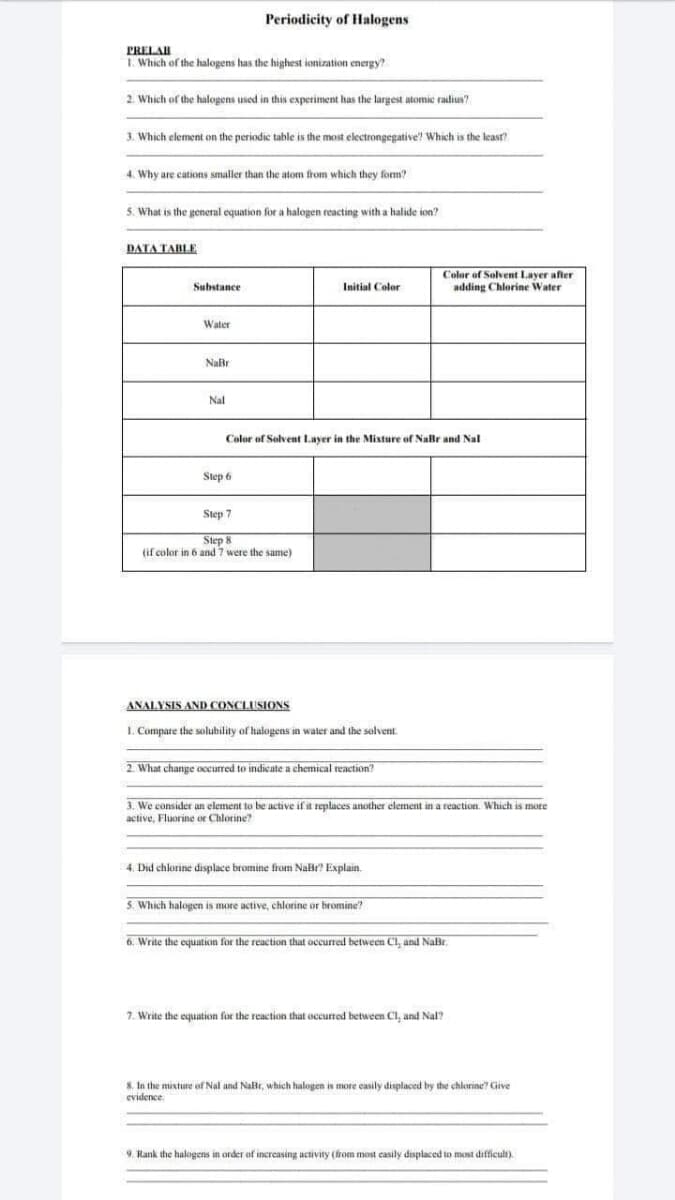Periodicity of Halogens PRELAH 1. Which of the halogens has the highest ionization energy? 2. Which of the halogens used in this experiment has the largest atomic radiun? 3. Which element on the periodie table is the most electrongegative? Which is the least? 4. Why are cations smaller than the atom from which they form?
Periodicity of Halogens PRELAH 1. Which of the halogens has the highest ionization energy? 2. Which of the halogens used in this experiment has the largest atomic radiun? 3. Which element on the periodie table is the most electrongegative? Which is the least? 4. Why are cations smaller than the atom from which they form?
Chemistry
10th Edition
ISBN:9781305957404
Author:Steven S. Zumdahl, Susan A. Zumdahl, Donald J. DeCoste
Publisher:Steven S. Zumdahl, Susan A. Zumdahl, Donald J. DeCoste
Chapter1: Chemical Foundations
Section: Chapter Questions
Problem 1RQ: Define and explain the differences between the following terms. a. law and theory b. theory and...
Related questions
Question

Transcribed Image Text:Periodicity of Halogens
PRELAH
T. Which of the halogens has the highest ionization energy?
2. Which of the halogens used in this experiment has the largest atomie radius?
3. Which element on the periodic table is the most electrongegative? Which is the least?
4. Why are cations smaller than the atom from which they form?
5. What is the general equation for a halogen reacting with a halide ion?
DATA TABLE
Color of Solvent Layer after
adding Chlorine Water
Substance
Initial Color
Water
NaBr
Nal
Color of Solvent Layer in the Mlixture of NaBr and Nal
Step 6
Step 7
Step &
(if color in 6 and 7 were the same)
ANALYSIS AND CONCLUSIONS
1. Compare the solubility of halogens in water and the salvent.
2. What change occurred to indicate a chemical reaction?
3. We consider an element to be active if it replaces another element in a reaction. Which is more
active, Fluorine or Chlorine?
4. Did chlorine displace bromine from NaBr? Explain.
5. Which halogen is more active, chlorine or bromine?
6. Write the equation for the reaction that occurred between Cl, and NaBr.
7. Write the equation for the reaction that occurred between Cl, and Nal?
8. In the mixture of Nal and NaBr, which halogen is more casily displaced by the chlorine? Give
evidence
9. Rank the halogens in order of incrcasing activity (from most casily displaced to mont difficult).
Expert Solution
This question has been solved!
Explore an expertly crafted, step-by-step solution for a thorough understanding of key concepts.
Step by step
Solved in 3 steps

Knowledge Booster
Learn more about
Need a deep-dive on the concept behind this application? Look no further. Learn more about this topic, chemistry and related others by exploring similar questions and additional content below.Recommended textbooks for you

Chemistry
Chemistry
ISBN:
9781305957404
Author:
Steven S. Zumdahl, Susan A. Zumdahl, Donald J. DeCoste
Publisher:
Cengage Learning

Chemistry
Chemistry
ISBN:
9781259911156
Author:
Raymond Chang Dr., Jason Overby Professor
Publisher:
McGraw-Hill Education

Principles of Instrumental Analysis
Chemistry
ISBN:
9781305577213
Author:
Douglas A. Skoog, F. James Holler, Stanley R. Crouch
Publisher:
Cengage Learning

Chemistry
Chemistry
ISBN:
9781305957404
Author:
Steven S. Zumdahl, Susan A. Zumdahl, Donald J. DeCoste
Publisher:
Cengage Learning

Chemistry
Chemistry
ISBN:
9781259911156
Author:
Raymond Chang Dr., Jason Overby Professor
Publisher:
McGraw-Hill Education

Principles of Instrumental Analysis
Chemistry
ISBN:
9781305577213
Author:
Douglas A. Skoog, F. James Holler, Stanley R. Crouch
Publisher:
Cengage Learning

Organic Chemistry
Chemistry
ISBN:
9780078021558
Author:
Janice Gorzynski Smith Dr.
Publisher:
McGraw-Hill Education

Chemistry: Principles and Reactions
Chemistry
ISBN:
9781305079373
Author:
William L. Masterton, Cecile N. Hurley
Publisher:
Cengage Learning

Elementary Principles of Chemical Processes, Bind…
Chemistry
ISBN:
9781118431221
Author:
Richard M. Felder, Ronald W. Rousseau, Lisa G. Bullard
Publisher:
WILEY